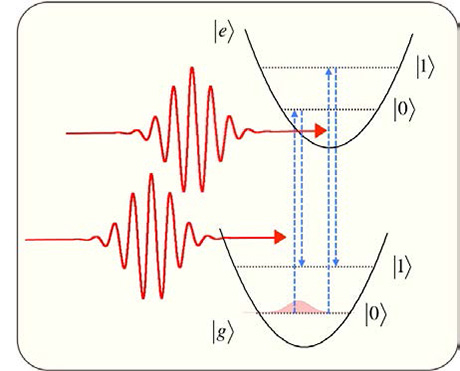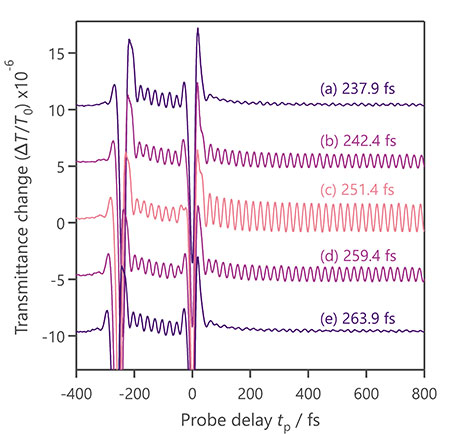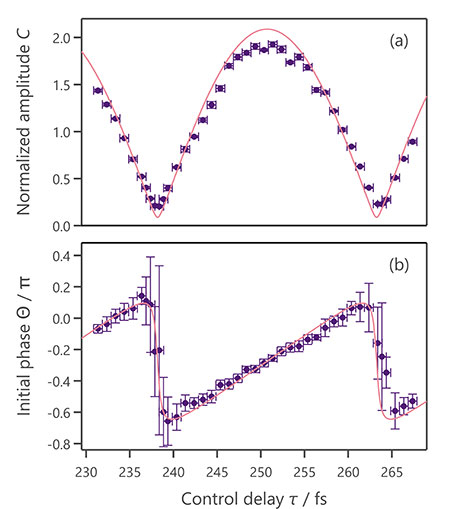Ultrashort Light-pulse-induced vibrations of atoms in a lattice, called optical coherent phonons, have been controlled in various materials. However, different experiments demonstrating such control have been explained differently through empirical theories, and a unified theory based on quantum mechanics is lacking. Scientists at Tokyo Institute of Technology successfully formulated a unified theory for this phenomenon and experimentally verified it in diamond, the optical phonons of which have great potential for application in quantum information technology.

Figure 1. Schematic of coherent control of optical phonons
Coherent optical phonons are coherently controlled by a pair of ultrashort optical pulses. |g> and |e> indicate the electronic ground and excited states and |0> and |1> indicate zero- and one-phonon state, respectively.
When extremely short optical pulse enters a solid, the atoms in its lattice start vibrating. Collectively, such vibrations of atoms exhibit both wave-like and particle-like behavior, and in quantum mechanics, these vibrations are called coherent optical phonons because they are induced by light and oscillate in phase. Phonons can determine various physical properties of solids, such as thermal and electrical conductivities. In previous experiments, the properties of coherent optical phonons, such as amplitude and phase, have been successfully controlled in various materials through a technique called coherent control, which has been made possible by advances in ultrafast laser technology. However, the results of different coherent control experiments have been explained using different empirical theories. Therefore, a unified quantum mechanical theory that explains the control of optical phonons is required.

Figure 2. Amplitude control of phonon oscillation in diamond
Transmittance change of the probe pulse plotted against the delay of the probe pulse with respect to the second pump pulse for five different time gaps between the two pump pulses [(a) to (e)]. The spikes are caused by the overlapping of the probe pulse with the first or second pump pulse. The change in amplitudes of the sinusoidal waves after the second set of spikes confirms that the coherent control of phonons is realized by varying the time gap.
Research team led by Professor Kazutaka G. Nakamura at Tokyo Institute of Technology (Tokyo Tech) collaborated with Professor Yutaka Shikano at Quantum Computing Center, Keio University and Institute for Quantum Studies, Chapman University recently formulated a theoretical framework that fundamentally and practically explains the generation and detection of coherent optical photons. The theory is based on a model involving two states of electrons as well as the quantum harmonic oscillator, one of the few quantum-mechanical systems for which an exact solution is known. Calculations based on this theory showed that the amplitude of a controlled phonon can be expressed by the sum of two sinusoidal functions.
To test this theory, the scientists conducted an experiment of coherent control in diamond. Diamond is a very important material in this field because the coherent control of its optical phonons is promising to develop quantum memory In the experiment, coherent control is achieved by employing two extremely short laser pulses, known as pump pulses: one pulse induces an oscillation, or phonons, while the other controls the amplitude of oscillation. The time gap between the two pulses is varied to control the properties of the generated phonons. A probe pulse sent with a delay after the two pump pulses is used to measure the properties of the generated phonons by detecting changes in the transmitted intensity of this pulse with respect to the delay.
The measured amplitude and phase of controlled oscillations induced by the pump pulses in diamond showed a remarkable agreement with the predictions of the theory. Thus, a comprehensive understanding of the coherent control of coherent optical phonons has been achieved. This theory is expected to be useful in the development of memory systems for quantum computing, in addition to other applications in electronics, optics, materials science, and superconductivity.

Figure 3. Agreement between the proposed theory and experiment
The points in the two figures show the experimentally measured amplitude and phase of the phonon oscillation with respect to the time gap between the two pump pulses. The points are consistent with the solid lines in the two figures, which represent the predictions of the proposed theory.
The measured amplitude and phase of controlled oscillations induced by the pump pulses in diamond showed a remarkable agreement with the predictions of the theory. Thus, a comprehensive understanding of the coherent control of optical phonons has been achieved. This theory is expected to be useful in the development of memory systems for quantum computing, in addition to other applications in electronics, optics, materials science, and superconductivity.
Reference
Authors : |
Hiroya Sasaki1, Riho Tanaka1, Yasuaki Okano2, Fujio Minami1,3, Yosuke Kayanuma1,4, Yutaka Shikano5,6,7,8, and Kazutaka G. Nakamura1 |
Title of original paper : |
Coherent control theory and experiment of optical phonons in diamond |
Journal : |
Scientific Reports |
DOI : |
|
Affiliations : |
1 Laboratory for Materials and Structures, Tokyo Institute of Technology, Japan
2 Center for Mesoscopic Sciences, Institute for Molecular Science, National Institutes of Natural Sciences, Japan
3 Department of Physics, Graduate School of Engineering, Yokohama National University, Japan
4 Graduate School of Sciences, Osaka Prefecture University, Japan
5 Quantum Computing Center, Keio University, Japan
6 Research Center for Advanced Science and Technology (RCAST), The University of Tokyo, Japan
7 Institute for Quantum Studies, Chapman University, USA
8 Research Center of Integrative Molecular Systems (CIMoS), Institute for Molecular Science, National Institutes of Natural Sciences, Japan
|
. Any information published on this site will be valid in relation to Science Tokyo.





